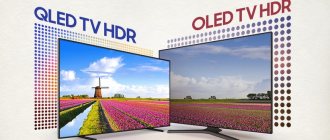Posted by Roman Kovalev - 03/11/2020 1506 comments
Many people, when wanting to buy a new TV, are faced with the problem of an abundance of various abbreviations, such as LCD, LED, OLED and QLED, the differences between which can still confuse an unenlightened person in the matter.
In this article we want to make a small comparison of LCD and LED TVs with a description of their features so that you understand what their differences are and what is better to buy based on your own needs and capabilities of the devices.
Plasma TVs
Plasma TVs consist of a series of cones filled with gas. If you apply voltage to it, plasma is formed. A phosphor is applied to the walls of the cones, which converts the ultraviolet glow of the plasma into radiation of a certain color - red, blue or green.
Interesting! A plasma panel is a matrix of gas-filled cells, each of which is coated with a special phosphor, and their glow occurs due to the formation of plasma.
As a result, any of the possible shades is formed. A distinctive feature of plasma TVs is their high energy consumption and heavy weight.
Due to the technology, the problem of partial or complete burnout of pixels arises when a static picture is displayed for a long time - the phosphor on the bulbs burns out. Plasma TVs were at the origins of thin TVs. They are characterized by a fast matrix response and high contrast, so you get a bright and rich image.
Currently, the popularity of plasma panels is declining; they have been replaced by LCD and LED TVs.
How does a plasma TV work?
Advantages:
- deep and rich colors;
- low black level, such TVs produce black color as close to ideal as possible;
- high contrast;
- almost complete absence of matrix response time - this means that plasma is excellent for dynamic images, i.e. for films;
- wide viewing angles (170 degrees);
Flaws:
- high price;
- It is undesirable to include a static image, photographs, for example, for a long time. As we already mentioned, this harms the health of the pixels.
LCD displays: main features and operating principle
Liquid crystal displays have replaced devices with kinescope displays. Unlike their predecessors, they are characterized by a long service life, low power consumption, no flicker, and low weight. In addition, when watching TV shows, your eyes do not get tired, and dust does not stick to the screen.
The design of such a display used liquid crystals located under pressure between two electrical boards. In this case, the change in color transmitted to the image occurs under the influence of electric current. The crystals themselves do not emit light or shade, they are used only to transmit them.
Under all crystals there are filters of four basic colors - yellow, red, green and blue. Light passing through the crystals between the two boards hits these filters, resulting in a certain shade being displayed on the screen.
However, to reproduce the picture on the screen, you need a backlight, which all LCD and LED TVs have. Not everyone knows what the difference between them is. Conventional LCD TVs use a single cold cathode lamp to illuminate the entire display. But in this case it is not possible to darken one part of the screen and lighten the other.
LCD TV
The phrase LCD display stands for “Liquid Crystal Display”, the synonym is LCD display. It consists of an LCD matrix, which in turn consists of two plates. Between them are liquid crystals. In addition to the matrix, the display design includes a backlight. Classic LCD TVs and monitors use CCFL backlighting - these are so-called cold cathode fluorescent lamps.
The backlight lamps are located at the end of the light-scattering layer of the matrix. The principle of operation is that liquid crystals located between two polarized plates change the polarization of light when a voltage is applied to them. The polarized plates between which the crystals are located have mutually perpendicular polarization. This means that light would not pass through these plates if there were no liquid crystals. Thus, by smoothly changing the polarization vector, you can change the intensity of light transmission through the matrix.
To obtain a color image, a color filter is applied to the cell. This is called a subpixel. There are red, green and blue subpixels. A group of subpixels of three colors is called a pixel. This part of the display is called a matrix because it consists of millions of such pixels.
The distinguishing feature of televisions in this group is their significantly lower weight and power consumption than plasma panels. Unfortunately, they have a lower viewing angle and contrast than plasma. The black color in LCD TVs is usually not completely black, but something between dark blue and dark gray tones. The response of the matrix is also lower than that of plasma panels. Manufacturers are using various technological tricks to improve the quality of LCD TVs.
Operating principle of LCD TV
Advantages:
- Relatively low cost;
- Great for displaying photos and other static information;
- Low power consumption;
- Service life up to 75,000 hours.
Flaws:
- High black level (closer to dark gray);
- Low contrast;
- Great response time.
Black level is measured in NT or nits, which is equal to 1 candela per 1 square meter of area. The lower the black level, the blacker the color.
LED or LCD TV – which is better?
LED TVs are special types of LCD TVs, but they differ from the latter in the type of backlight.
In fact, LEDs are used instead of lamps to illuminate the panel, as is the case with traditional LCD displays. This advanced technology results in noticeably improved images, with a wider range of colors, lower power consumption and a thinner TV. However, the cost of LCD screens with LEDs is higher.
What is the difference between them?
LCD (Liquid Crystal Display) or liquid crystal displays are very common nowadays on the screens of televisions, computer monitors, some watches, mobile phones and microwave ovens. The main advantage of LCD technology is the image, which is the result of the orientation of liquid crystals, which in turn consist of individual cells that make up the screen; Also another difference is the source of external lighting. LCDs work on the basis of a system of three primary colors that make up each pixel, however, liquid crystals do not light up on their own and it is for this reason that a backlight source is required, CCFLs are used for this purpose i.e. cold cathode fluorescent lamps.
LCD TV.
These models of LCD screens are much thinner and lighter than the old CRT (Cathode Ray Tube), require less power and do not emit electromagnetic radiation, also this type of technology allows for brighter images, higher resolution and less flickering of the display, they are less harmful eyes. To work properly, the light from the backlight must be non-polarized white light.
The main disadvantages of LCD screens relate to diagonal vision: in fact, light must go through two stages of polarization before reaching our eyes. Another issue concerns contrast and black intensity, which are not the best. LCD black color is not absent from the system, it consists not only of the absence of light, but also of masking the backlight. LCD technology can have latency issues, it actually takes a little time before the liquid goes into a crystalline state, sometimes there is also the possibility of pixel burn-in.
LED TV: advantages and disadvantages
Basically, LED TVs are LCD TVs. But instead of CCFL lamps, they have LEDs in the backlight. Due to this, energy consumption is further reduced. There are several options for LED backlighting:
- The placement of LEDs along the edge, the so-called Edge option. It is no different from CCFL backlighting. High contrast cannot be achieved. LEDs located around the perimeter of the screen shine on the light-diffusing glass, after which the liquid crystals transmit or do not transmit light. The problem is that closed (turned off) crystals still allow some light to pass through. Therefore, it is not possible to achieve depth of black;
- To solve this problem, we developed LED carpet backlighting for displays. This technology is called differently depending on the manufacturer, for example Full HD LED or LED pro. This technology allows for improved illumination uniformity, and individual diodes can dim their brightness to increase contrast and achieve a blacker color than with previous technology.
Advantages:
- acceptable, and in expensive models there is good image contrast;
- good color rendering;
- low weight;
- low power consumption;
- the use of LED backlight eliminates the high-voltage inverter for igniting lamps from the circuit. And it most often failed in CCFL LCD screens;
- LED TVs are thinner than LCD: the thickness of modern models reaches 4 mm.
Dynamic RGB direct backlighting in LED TV
The only significant drawback is the high cost of LED monitors and TVs, but recently this problem has been solved - there is a tendency for prices to decrease.
What is LCD TV
LCD is short for liquid crystal. In the English version it sounds like this - Liquid crystal display (LCD). Thus, it immediately becomes clear that LCD and LCD are one and the same. To understand how an LED TV differs from an LCD TV, it is worth understanding the operating principle of an LCD screen.
So, an LCD TV is a device that operates on the basis of a special substance, which is called liquid crystals for its combination of unique properties. The molecules of this substance are always in a liquid state, and when exposed to electricity, they are able to change their position. At the same time, the molecules of liquid crystals have optical properties inherent in a crystal, which is why they got their name.
1.1. Working principle of LCD display
The basis of an LCD TV is the matrix. This is a whole array that consists of liquid crystal molecules. If you influence molecules with an electromagnetic field, they will change their position, refracting rays of light, while transmitting only the required spectrum of radiation.
In other words, by influencing the molecules of liquid crystals we can control the process of transmitting and blocking one or another spectrum of radiation, thereby creating a certain picture on the screen. Of course, the crystal molecules themselves are not capable of generating light. Depending on the design of the matrix, molecules can work either to reflect light or transmit it.
As you may have guessed, the LCD matrix requires an artificial light source to operate. The first LCD models used fluorescent lamps. However, they could not achieve the most even distribution of light across the entire plane of the matrix, and also did not have the highest brightness and radiation intensity. This caused low brightness of the displays.
In addition, when the screen displayed black, you could see bright areas around the edges of the display - this is the light from the lamps. To eliminate this problem, LED technology was developed. This is the LCD matrix backlight system.
Thus, the answer to the question of how an LCD TV differs from an LED TV is nothing, since these are two components of the same technology.
Types of LCD and LED TV matrices
Today the popular types are:
- IPS are currently installed mainly in LG TVs of the low and mid-price segment 3-6 series and Philips 4 and 6 series, as well as on Panasonic. With its help, the developers managed to achieve large viewing angles. Its disadvantage is a fairly high black level (approximately 0.16 nits) and a long response time;
- S-PVA, manufactured by Samsung. Installed on Samsung, Panasonic and Sony 7 and 8 series TVs. Features a low black level (from 0.05 to 0.1 nits). Viewing angles are smaller than IPS;
- UV²A - this type is manufactured by Sharp. Installed in top Philips and Sharp models. Their viewing angle is between S-PVA and IPS, and the black level is the lowest and deepest - from 0.02 to 0.06, which is comparable to the black level of plasma panels.
Construction of an IPS type panel Construction of a VA type panel
Comparative characteristics of LCD, plasma and LED TVs
For greater clarity, let's compare the distinctive features of each type of TV - LCD, LED, plasma.
- Screen size. Previously, due to the design features, plasma panels had large diagonals; currently, a number of diagonals start from 42″. LCD and LED TVs can be manufactured in any size. For example, mobile phone screens have been manufactured using these technologies for more than 15 years;
- Contrast. In the first place in this category are plasma panels, LED in second, and LCD in third, although for liquid crystal displays the type of matrix plays a big role in the image;
- Depth of black. This value is related to the contrast of the image; plasma technology is also in the lead, and in liquid crystal displays, LED TVs with carpet backlighting and a UV2A matrix have the maximum black depth;
Black depth is related to image contrast - Viewing angle. Plasma models have very good viewing angles (170 degrees). For LCD and LED displays, this parameter strongly depends on the type of matrix used; the largest angles are typical for IPS;
- Fast response. Plasma TVs are also leaders in this category; they have a minimum matrix response time of about 1 ms. LCD displays are characterized by values from units to tens of ms;
- Uniformity of screen illumination. Plasma TVs have uniform illumination due to the fact that each pixel is a light source. But with LCDs the situation is more complicated. Most often, the backlight is located at the ends of the screen, with the exception of LEDs with carpet backlighting. CCFL lamps provide fairly uniform light; it is diffused in a special layer of the screen. And LEDs located along the edge usually give good results, but it greatly depends on their number;
- Glare in the sun. Comfort when watching TV under direct or tangential sunlight is affected by two factors - backlight brightness and screen coverage. LCD TVs often have brighter backlighting than plasma TVs, and the same applies to TVs with LED backlighting, so they are more comfortable to watch in bright light. There are screens with glossy and matte anti-glare coating. Matte screens have a small drawback - they have slightly faded colors compared to glossy ones. But if the TV is placed opposite the window, then watching it under the bright rays of the sun will be nothing but torture. It is worth choosing the screen type individually;
Choose a TV based on its installation location - Screen burn-in. Screen burnout is most likely to occur when the plasma panel displays a static image for a long time. When working with dynamic content, all types of screens fully fulfill their service life;
- Energy efficiency. Today, LED TVs are the most economical in terms of energy consumption, LCDs occupy an intermediate position, and plasma panels consume the most in this comparison;
- Durability. The most durable are LCD and LED TVs, their service life reaches 100,000 hours. Although in fact this value is limited by the service life of lamps and LEDs - the matrix itself continues to work after replacing the backlight. A plasma panel has a lifespan of 30,000-60,000 hours. At the same time, this is the service life of the matrix itself, since it also plays the role of backlight;
- Price. LCD TVs are the cheapest, while plasma and LED TVs are the most expensive.
It is worth noting that low-quality CCFL backlight lamps can fade over time and produce worse light, the same applies to cheap Chinese LED products.
The difference between LED and LCD TVs
As you already know, it is impossible to say which is better - an LCD or LED TV, since in essence they are the same thing. An erroneous concept among buyers appeared due to incorrect advertising, or rather due to marketing ploys, the main purpose of which is to increase the sales of products.
Of course, there is a difference between LCD and LED TVs. After all, an LCD TV does not have to be equipped with LED backlighting. Very often there are models that have fluorescent lamps that act as a source of light emission, while LED is necessarily a liquid crystal TV. But at the same time, it is impossible to say which TV is better than LCD or LED, since after all, these are two parts of one whole.
Tips for choosing
All types of TVs are good in their own way; to choose a model that suits your needs, you need to decide what is your priority. The comparison above and these five tips from the experts will help you with this:
- If high contrast and deep colors are important to you, a plasma TV is perfect;
- For those whose TV works almost 24 hours a day or for use in public places, such as cafes and bars, an LED TV will be the best choice: they have a long service life and low power consumption;
- If the budget is very limited, but you want a large screen, then it is more profitable to purchase an LCD TV;
- Pay attention to the ability to play multimedia from a USB flash drive - this way you can save on purchasing an additional player;
- Access to the Internet via TV will make it easier for older people to learn new technologies, and will also be useful for those who have small children to play cartoons on Youtube.
Watch a video about which TV to choose
How to choose a TV? LED TVs, LCD TVs, Plasma TVs: Video
There are, of course, some disadvantages. For example, LED backlighting makes the image tones cooler, with some bluish or even greenish tints, but this can be eliminated by simply adjusting the brightness and contrast, as well as adjusting the color tones. In addition, if we talk about PC monitors, you can calibrate the image, which will help make the picture as natural as possible.
Taking into account all of the above, we can safely say that it is wrong to raise the question of which is better LED or LCD. However, we can say that LCD TVs with LED backlighting are better than simple LCD models, since in the second case fluorescent lamps are used. Such TVs are considered outdated and have lower performance than LCD displays with LED backlighting.











